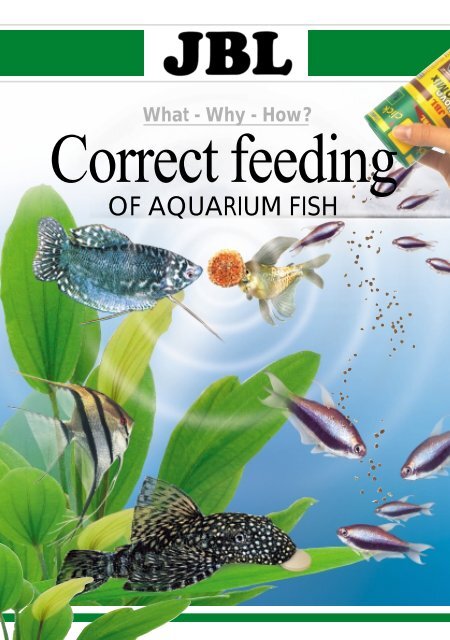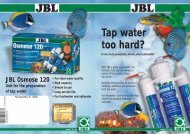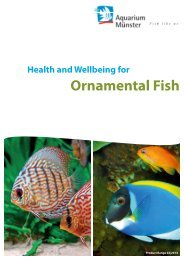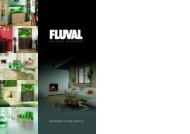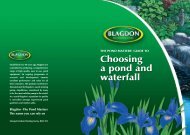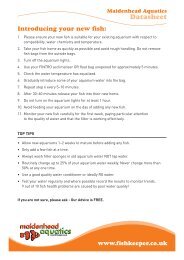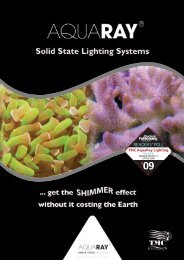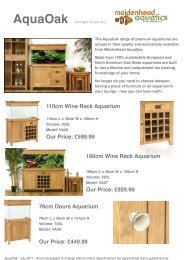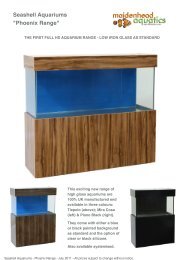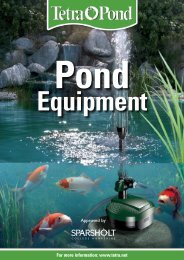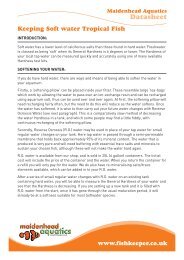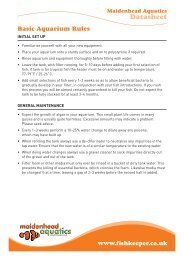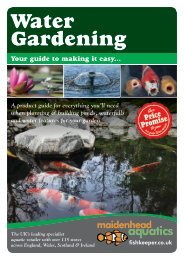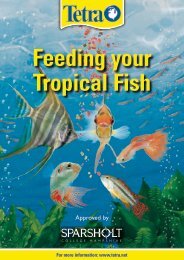Correct Feeding of Aquarium Fish(7.17MB)
Correct Feeding of Aquarium Fish(7.17MB)
Correct Feeding of Aquarium Fish(7.17MB)
You also want an ePaper? Increase the reach of your titles
YUMPU automatically turns print PDFs into web optimized ePapers that Google loves.
What - Why - How?<br />
<strong>Correct</strong> feeding<br />
OF AQUARIUM FISH
Ahead<br />
through research<br />
Contents Page<br />
1. Why species-specific feeding? 2<br />
2. The ingredients 2 - 7<br />
3. Looking at the feeding habits <strong>of</strong> fish<br />
"How much" protein, fat etc.? 8 - 9<br />
Various forms <strong>of</strong> feed 10 - 13<br />
Food for specific groups <strong>of</strong> fish 14 - 16<br />
4. Varied feeding 17 - 18<br />
5. <strong>Feeding</strong> techniques 19<br />
6. <strong>Fish</strong> fry 20 - 21<br />
7. The wide range <strong>of</strong> JBL feeds 22 - 27<br />
8. Supplementary vitamins 28<br />
9. Pr<strong>of</strong>essional feeding and care...<br />
JBL feeding table 29<br />
Published by<br />
JBL GmbH & Co.KG<br />
D- 67141 Neuh<strong>of</strong>en/Pfalz<br />
www.jbl.de<br />
3rd revised edition 2006<br />
Texts: Dr. Rainer Keppler,<br />
Biologe im Hause JBL<br />
Layout: akzenta PR, D- 53797 Lohmar
Ahead through research<br />
INTRODUCTION<br />
Over millions <strong>of</strong> years fish, like all other<br />
forms <strong>of</strong> life, have adapted themselves to<br />
certain feeding methods and forms <strong>of</strong> nourishment<br />
which are available in sufficient<br />
quantities in their natural habitat. Only in<br />
very rare cases do aquarium fish find adequate<br />
quantities <strong>of</strong> any one type <strong>of</strong> feed in<br />
their tank without our assistance.<br />
One <strong>of</strong> the most important and interesting<br />
tasks <strong>of</strong> an aquarium keeper is to feed the fish<br />
in a healthy and sensible manner as well as to<br />
consider the environmental conditions.<br />
It is not only a question <strong>of</strong> feeding fish sufficient<br />
quantities <strong>of</strong> just any feedstuff. It is<br />
most important that the special feeding<br />
requirements <strong>of</strong> the "water babies"<br />
are met as closely as possible.<br />
This brochure explains the<br />
significance <strong>of</strong> species-specific<br />
feeding and shows you how to<br />
provide healthy and<br />
varied feeds which<br />
specifically meet the<br />
needs <strong>of</strong> your aquarium<br />
fish using the wide<br />
range <strong>of</strong> JBL fish<br />
food.<br />
1
2<br />
1. WHY<br />
SPECIES-SPECIFIC<br />
FEEDING?<br />
A range <strong>of</strong> feeds whose composition<br />
meets the natural requirements <strong>of</strong> fish<br />
as fully as possible makes a vital contribution<br />
to building up the fishes' resistance<br />
to diseases and parasites, when<br />
combined with suitable environmental<br />
conditions such as water quality etc.<br />
Varied and specific feeds also improve<br />
readiness to spawn.<br />
Incorrect feeding, as well as causing possible<br />
damage to internal organs (e.g.<br />
fatty liver, inflammation <strong>of</strong> the intestines<br />
etc.), may also weaken the immune<br />
system and therefore enable potential<br />
disease carriers to attack the fish.<br />
2. WHAT INGREDIENTS<br />
SHOULD SPECIES-SPECIFIC FEED FOR AQUARIUM FISH CONTAIN<br />
Considering the enormous variety <strong>of</strong><br />
foodstuff which many species <strong>of</strong> fish find<br />
in their natural habitat, it seems impossible<br />
at first sight to meet all the different<br />
requirements in an aquarium.<br />
But however varied the individual sources<br />
and the ecological niches <strong>of</strong> the different<br />
types may be, results <strong>of</strong> much<br />
research in this field show that all these<br />
sources <strong>of</strong> food have certain ingredients<br />
in common which are vital to healthy and<br />
specific nutrition.<br />
Using this information it is now possible,<br />
for example, to produce flaked feeds<br />
<strong>Fish</strong> which have been fed correctly<br />
according to their needs are able to cope<br />
very well with temporarily stressful<br />
situations without an outbreak <strong>of</strong> illness.<br />
For example, transport, temporary fluctuations<br />
in water values, handling in the<br />
tank etc. are all factors which can cause<br />
stress. We must however point out that<br />
even the best feeding cannot compensate<br />
for permanent stress, (e.g. constantly<br />
incorrect water values, incorrect<br />
association <strong>of</strong> species etc.) <strong>Fish</strong> kept<br />
incorrectly will sooner or later fall victim<br />
to disease!<br />
The correct feeding <strong>of</strong> aquarium fish<br />
should always be combined with<br />
thoughtful design <strong>of</strong> the fishes' environment.<br />
?<br />
which contain all the vital ingredients for<br />
one particular type <strong>of</strong> fish.<br />
These are:<br />
proteins, lipids (fats), carbohydrates, fibres,<br />
vitamins and minerals.<br />
Proteins<br />
Proteins are the most important elements<br />
<strong>of</strong> all animal organisms. Growth<br />
cannot take place without them.<br />
Proteins consist <strong>of</strong> many amino acids,<br />
joined together like links in a chain, the<br />
order determining the function <strong>of</strong> the<br />
particular protein in the organism. Of all<br />
the amino acids known so far, 12 are<br />
considered to be vital ( or essential) for<br />
fish according to today's scientific thinking.<br />
This means that these 12 amino<br />
acids must be present in sufficient quantities<br />
and in specific proportions in the<br />
protein component <strong>of</strong> the fish food.<br />
All the other amino acids needed by the<br />
fish to make their own proteins can be<br />
produced in the body from these 12<br />
essential ingredients. The protein sources<br />
which ideally meet these requirements<br />
are primarily organisms found in<br />
water, especially fish themselves, and<br />
plant protein carriers, e.g. soya. JBL<br />
fish feed therefore contains a balanced<br />
Take a magnifying glass to your feed.<br />
JBL feed flakes are produced only from<br />
carefully selected, high-quality<br />
raw materials e.g.:<br />
1 fish meat<br />
2 shrimps/ common<br />
freshwater shrimps<br />
3 soya beans<br />
4 yeast<br />
PROTEINS<br />
LIPIDS (FATS)<br />
CARBOHYDRATES<br />
FIBRES<br />
VITAMINS<br />
MINERALS<br />
combination <strong>of</strong> different protein sources<br />
such as fish, shrimps, soya and others.<br />
As fish, in contrast to warm-blooded<br />
creatures (birds, mammals, man), need<br />
proteins not only for growth but also in<br />
part as an energy source for movement,<br />
fish food must also contain more protein<br />
than food for warm-blooded pets.<br />
3
Lipids or fats<br />
Particular attention should be paid to the role Carbohydrates originate almost exclusi-<br />
4 <strong>of</strong> fats in the feeding <strong>of</strong> fish. Fats provide fish vely from the plant world and are characte- The starch content <strong>of</strong> JBL flaked feed<br />
5<br />
above all with an easily accessible and highly<br />
nutritious source <strong>of</strong> energy for movement and<br />
metabolism, both <strong>of</strong> which use a great deal <strong>of</strong><br />
energy. However, fish are not able to digest<br />
every type <strong>of</strong> fat i.e. use them as an energy<br />
source.<br />
A general rule: only those fats which<br />
are liquid at the optimum temperature<br />
required by a particular species <strong>of</strong> fish,<br />
(as a rule approx. 25°C), are suitable<br />
nourishment for that type <strong>of</strong> fish.<br />
The fats obtained from warm-blooded animals,<br />
(cows, pigs etc.), are solid at these<br />
temperatures and, if included in the feeds,<br />
would be excreted in an almost undigested<br />
state, which could lead to serious inflammation<br />
<strong>of</strong> the intestines.<br />
Fats obtained from aquatic organisms are<br />
ideal for feeding fish. They contain the socalled<br />
unsaturated fats which are essential<br />
for growth, health and colouring. Some<br />
vegetable fats also contain these unsaturated<br />
fats, but in far lower quantities.<br />
By processing fish oil, shrimps and other<br />
aquatic organisms, as well as soya, JBL<br />
fish feed contains fat which ideally meets<br />
these requirements.<br />
Carbohydrates<br />
rised by sugar, starch and cellulose. With<br />
the exception <strong>of</strong> plant-eating fish, starches<br />
and cellulose, because <strong>of</strong> their complex<br />
structure, can be utilised by fish very little,<br />
if at all. Simpler structures, such as glucose,<br />
can be more easily used and are<br />
useful to a certain extent as an energy<br />
source in feed.<br />
Cooking breaks down starch, and to some<br />
degree cellulose too, into its basic components<br />
making it "digestible".<br />
moisture 6.3%<br />
NfE<br />
32,8 %<br />
(carbohydrate)<br />
JBL NOVObel<br />
crude protein 45.2%<br />
crude ash 9.7%<br />
crude fibre 1.4%<br />
Rohfett 7,5%<br />
The danger <strong>of</strong> incorrect feeding is far greater in an<br />
aquarium than in the wild. Therefore it is important<br />
that fish feed for aquarium fish contains all<br />
the vital ingredients in carefully balanced proportions.<br />
Starches treated in this manner, (as<br />
already described for glucose), may be utilised<br />
by fish in certain amounts.<br />
is made more easily digestible for<br />
fish by being heated during<br />
the manufacturing process.<br />
At the same time the starch<br />
content ensures that the<br />
individual ingredients stay<br />
combined together in the<br />
typical flake form.<br />
The use <strong>of</strong> a wide spectrum<br />
<strong>of</strong> different types <strong>of</strong> grains,<br />
vegetables and herbs in<br />
JBL Flake Foods provides a<br />
healthy, varied range <strong>of</strong><br />
vegetable starch carriers<br />
and vital vegetable matter<br />
for all species <strong>of</strong> fish. The<br />
ingredients contained in highgrade<br />
herbs with their essential<br />
oils, alkaloids and other<br />
valuable substances make the<br />
food readily acceptable to fish<br />
and improve their vitality. In particular,<br />
the ingredients contained<br />
in the garlic counteract diseases<br />
and ensure that the fish remain<br />
healthy.<br />
Fibres<br />
Fibres, (mainly vegetable),<br />
have no<br />
direct nutritional<br />
value themselves<br />
but are responsible<br />
as ballast material<br />
for the correct functioning<br />
<strong>of</strong> the digestive<br />
system, as in humans too.<br />
JBL flaked feeds contain a variety <strong>of</strong><br />
vegetable raw materials which provide<br />
the correct fibre content.<br />
JBL's flake feed range <strong>of</strong>fers a wide<br />
variety <strong>of</strong> species-specific feeds for even the<br />
most fastidious <strong>of</strong> fish.
6<br />
Vitamins and Minerals<br />
Vitamins are active substances which<br />
similarly have no nutritional function. They<br />
control many vital metabolic functions. For<br />
this reason vitamins are required in much<br />
lower quantities than other forms <strong>of</strong> nutrition.<br />
Lack <strong>of</strong> vitamins may, however, lead to<br />
serious and <strong>of</strong>ten irreversible damage to<br />
the organism.<br />
Lack <strong>of</strong> vitamins<br />
leads to duller<br />
colours as well as<br />
reduced resistance<br />
and immunity.<br />
Vitamins A and E are especially important.<br />
Vitamin A increases the body's resistance<br />
to disease, promotes growth, health and<br />
vision. Vitamin E improves fertility above<br />
all, (hence the name given to it in the past<br />
the "fertility vitamin"), and protects vitamin<br />
A and the unsaturated fats mentioned earlier<br />
against decay.<br />
The fats with many unsaturated fatty acids,<br />
which play a vital role in the diet <strong>of</strong> fish, as<br />
already mentioned, are highly perishable.<br />
Oxygen in the air quickly leads to the oxidation<br />
(becoming rancid) <strong>of</strong> these unsaturated<br />
fatty acids in the food.<br />
This renders the food practically worthless,<br />
even damaging for the fish, not to mention<br />
the unpleasant smell. Vitamin E also plays<br />
an important role here in protecting the<br />
valuable unsaturated fatty acids in the food<br />
from decay. Substances which have this<br />
protective function are referred to as antioxidants.<br />
In addition to Vitamin E, some chemical<br />
compounds also have this function. One<br />
well-known compound is ethoxyquin.<br />
Since JBL places great emphasis on using<br />
natural ingredients wherever possible, JBL<br />
only uses antioxidants based on Vitamin E.<br />
JBL GALA is especially rich<br />
in minerals due to the inclusion<br />
<strong>of</strong> a high quantity <strong>of</strong><br />
spirulina algae, which have<br />
also proved a valuable source<br />
<strong>of</strong> minerals in the human<br />
diet.<br />
As end-user you can see this in the declaration<br />
"with antioxidant E 306”. Under the<br />
regulations relating to the ingredients in<br />
food, this indicates plant extracts with a<br />
high Vitamin E content.<br />
For species-specific care <strong>of</strong> your fish in the aquarium, all JBL flake foods contain a<br />
balanced multivitamin complex.<br />
Vitamin C, like vitamin A, improves resistance<br />
to infections <strong>of</strong> all kinds and builds<br />
up the body's resistance to all types <strong>of</strong><br />
stress. JBL flaked feed uses a new kind<br />
<strong>of</strong> vitamin C which is especially stable and<br />
insensitive to heat and other influences<br />
such as light and moisture.<br />
All JBL flaked feeds contain a well-balanced<br />
multivitamin complex which meets the<br />
requirements <strong>of</strong> all aquarium fish. In addition,<br />
JBL adds Inositol to the feed.<br />
VITAMIN A<br />
VITAMIN D3 VITAMIN E<br />
VITAMIN C (stable)<br />
VITAMIN B<br />
BIOTIN ; FOLIC ACID etc.<br />
Inositol is an active ingredient similar to<br />
vitamins which counteracts fatty degeneration<br />
<strong>of</strong> the liver and stimulates growth by<br />
improving the absorption <strong>of</strong> food by the<br />
intestines. The quantity <strong>of</strong> vitamins and Inositol<br />
in the product is printed on every pack<br />
<strong>of</strong> JBL NOVO feed.<br />
The inclusion <strong>of</strong> fish bonemeal and various<br />
shellfish in all JBL flaked feeds guarantees<br />
sufficient levels <strong>of</strong> minerals in the products.<br />
7
8<br />
3. LOOKING AT THE<br />
FEEDING HABITS OF FISH.<br />
As you can well imagine, given the great variety <strong>of</strong> species <strong>of</strong> fish<br />
and habitats, not every fish eats the same food. The feeding habits<br />
<strong>of</strong> most aquarium fish are known almost exactly as a result <strong>of</strong> extensive observations by<br />
numerous scientists <strong>of</strong> fish both in aquariums and in the wild. You too can learn more<br />
about your own aquarium fish at home by closely studying their feeding habits.<br />
How much protein, fat<br />
etc. do aquarium fish<br />
need?<br />
You have now learned about the individual<br />
ingredients which high-quality feed for<br />
aquarium fish should contain. So far "how<br />
much" has not been mentioned. That is<br />
what we are going to look at right now.<br />
<strong>Fish</strong> may be divided into three main<br />
groups according to their feeding habits<br />
and the type <strong>of</strong> nutrition preferred:<br />
1. meat-eating or carnivorous fish<br />
2. omnivorous fish<br />
3. plant-eating or herbivorous fish<br />
The first group consists <strong>of</strong> fish which<br />
hardly ever come into consideration as<br />
aquarium fish because <strong>of</strong> their predatory<br />
habits (they eat other fish). They must be<br />
fed almost exclusively with live fish.<br />
Most aquarium fish belong to one <strong>of</strong> the<br />
two groups <strong>of</strong> omnivorous or herbivorous<br />
fish, whereby some form an intermediate<br />
group. To find out which fish belongs to<br />
which group, either carry out your own<br />
observations or consult some <strong>of</strong> the comprehensive<br />
specialist aquarium literature.<br />
In addition to the concern <strong>of</strong> meeting the<br />
Table 1 Crude protein/ fat content<br />
Omnivorous fish Herbivorous fish<br />
40/ 45%<br />
7/ 9%<br />
crude protein fat<br />
30/ 35% 3/ 5%<br />
nutrient needs <strong>of</strong> the species as closely as<br />
possible, the effect <strong>of</strong> the ingredients in the<br />
food on the water quality <strong>of</strong> the aquarium<br />
plays a significant role in the selection and<br />
combination <strong>of</strong> the food components.<br />
As already mentioned elsewhere, the<br />
metabolism <strong>of</strong> the fish functions in such a<br />
way that proteins are not only required for<br />
growth but, together with fats and carbohydrates,<br />
are also a source <strong>of</strong> energy. However,<br />
the use <strong>of</strong> proteins as a source <strong>of</strong><br />
energy has a negative effect on the ecosystem<br />
<strong>of</strong> the aquarium. The nitrogen released<br />
during the digestion <strong>of</strong> proteins to produce<br />
energy cannot be used by the fish<br />
and is exuded through the gills in the form<br />
<strong>of</strong> ammonium.<br />
This is converted via nitrite to nitrate in the<br />
aquarium and pollutes the water as an<br />
undesirable algae nutrient. The addition <strong>of</strong><br />
the appropriate fats as an energy carrier<br />
drastically reduce the amount <strong>of</strong> water-polluting<br />
waste products.<br />
Due to the limited opportunities for the fish<br />
to move in the aquarium, large amounts <strong>of</strong><br />
fat can lead to damage caused by fatty<br />
degeneration <strong>of</strong> the organs, affecting the<br />
health <strong>of</strong> the fish and reducing their lifespan.<br />
The ideal composition is a balanced combination<br />
<strong>of</strong> proteins and other energy carriers<br />
such as fats and carbohydrates,<br />
which, within the framework <strong>of</strong> the possible<br />
tolerances, are suitable for the species<br />
and at the same time "kind” to the water.<br />
Table 2 Carbohydrate/ dietary fibre<br />
Omnivorous fish Herbivorous fish<br />
45%<br />
30%<br />
1/ 2%<br />
3/ 5%<br />
carbohydrate fibre<br />
Taking these points into consideration, the<br />
following levels have proved to be the<br />
best. For omnivorous fish and species<br />
which tend more to a carnivorous diet, protein<br />
levels <strong>of</strong> 40 – 45% are ideal, whereas<br />
herbivorous fish need significantly less,<br />
namely 30 – 35%. Vegetable protein carriers<br />
such as soya, wheat protein, proteins<br />
from algae etc., should be included as far<br />
as possible for herbivorous fish. Fat levels<br />
<strong>of</strong> 7 – 9% for omnivorous species and 3 –<br />
5% for herbivorous species have proved<br />
their worth, taking into account the aspects<br />
mentioned above.<br />
The demand for carbohydrates is exactly<br />
in reverse proportion to the protein content.<br />
Herbivorous species need more carbohydrates<br />
in their food than omnivorous<br />
fish. Like fats, carbohydrates are a readily<br />
available source <strong>of</strong> energy. Together with<br />
the higher carbohydrate content, the herbivorous<br />
fish also get more ballast material,<br />
vital for their digestive system to function<br />
correctly. Herbivorous fish require a<br />
ballast content <strong>of</strong> 3 – 5%, and many herbivorous<br />
armoured catfish, which have<br />
become specialised in digesting wood<br />
fibre, even require over 10%. For omnivorous<br />
fish, a ballast level <strong>of</strong> 1 – 2% is sufficient.<br />
The entire digestive system <strong>of</strong><br />
the fish has adapted<br />
itself over the<br />
course <strong>of</strong> evolution<br />
to the<br />
composition <strong>of</strong> the food,<br />
using it to the optimum. For<br />
example, herbivores have long<br />
intestines, ideally suited to a vegetable<br />
diet which is difficult to digest.<br />
Omnivorous or meat-eating fish have much<br />
shorter intestines suited to their easily digested<br />
diet which is rich in protein. Incorrect<br />
feeding may lead to serious disturbances<br />
<strong>of</strong> the digestive system.<br />
All JBL food sorts are designed to guarantee<br />
the correct nutritional value for the specific<br />
group <strong>of</strong> fish. Exact details may be<br />
found in the descriptions <strong>of</strong> the individual<br />
types <strong>of</strong> feed in Chapter 7 in this brochure.<br />
The intestines run in several coils through the<br />
body. The intestines <strong>of</strong> meat-eating fish are short<br />
and straight, whereas those <strong>of</strong> plant-eating fish<br />
(see diagram) are long and twisting.<br />
9
10<br />
Why different forms <strong>of</strong><br />
feed?<br />
The shape, size and position <strong>of</strong> the mouth<br />
on the body <strong>of</strong> the fish is an important indicator<br />
showing above all where and in what<br />
form the fish is accustomed to take in food.<br />
There are 3 main groups here too, referred<br />
to by the following specialist terms:<br />
<strong>Fish</strong> with superior mouths, anterior<br />
mouths and inferior mouths.<br />
1<br />
<strong>Fish</strong> with superior mouths<br />
Butterfly fish are solely surface fish, fetching<br />
their food mainly from the surface.<br />
The first group contains fish whose mouths<br />
slope upwards (e.g. the galaxidae, butterfly<br />
fish). The back line <strong>of</strong> these fish is<br />
straight and, as surface fish, they are<br />
adapted to feeding at<br />
the water's surface.<br />
<strong>Fish</strong> with anterior<br />
mouths have horizontal<br />
mouths pointing<br />
forwards and a body<br />
equally curved at the<br />
top and bottom (e.g.<br />
characine, barbells).<br />
These fish live in the<br />
middle water levels<br />
and feed there.<br />
3<br />
<strong>Fish</strong> with inferior<br />
mouths usually have bearded mouths, sloping<br />
downwards and a body which curves<br />
upwards, with a relatively flat belly line<br />
(e.g. armoured catfish, loaches). These<br />
fish feed on the floor, searching with their<br />
beards for food.<br />
There are many intermediate forms between<br />
groups 1 and 2. Occasionally<br />
fish from the middle water levels<br />
will look for food on the surface<br />
<strong>of</strong> the water and surface fish<br />
will look at lower levels.<br />
However, ground-feeding<br />
fish are reluctant to leave<br />
their "realm" to look for<br />
food in open water.<br />
<strong>Fish</strong> with inferior mouths<br />
JBL Novo flake food for surface-feeding<br />
fish and for fish <strong>of</strong><br />
the middle water levels.<br />
JBL NovoFect<br />
specially for planteatinggroundfeeding<br />
fish.<br />
The peace-loving catfish are a great enhancement<br />
to any mixed aquarium. They consume<br />
leftover food <strong>of</strong>f the floor and are also good<br />
eaters <strong>of</strong> algae.<br />
Surface fish require feed which floats on<br />
the surface <strong>of</strong> the water e.g. JBL NOVO<br />
flaked feed.<br />
JBL NovoStick M are specifically<br />
designed for larger aquarium<br />
fish like cichlids and<br />
others.<br />
JBL TABIS and<br />
JBL NovoTab for the specific<br />
feeding <strong>of</strong> fish in the middle<br />
levels and ground-feeding fish.<br />
Some <strong>of</strong> the feed flakes will<br />
sink slowly down and may<br />
therefore also be eaten by<br />
fish in the middle levels. In<br />
the wild surface-feeding fish<br />
also eat many insects which<br />
fall onto the surface <strong>of</strong> the water. Natural<br />
feed from the Novo range, e.g. JBL Novo-<br />
Fil, JBL NovoDaph etc, is composed <strong>of</strong><br />
feed organisms in their natural state, which<br />
ideally meet this requirement. The fish<br />
feed tablets JBL NOVOtab were developed<br />
for fish <strong>of</strong> the middle levels and for<br />
ground-feeding fish. The tablets can be<br />
dropped to the bottom, thus reaching the<br />
more "meat-orientated" ground fish. Or<br />
they may be attached in any position on<br />
the inside wall <strong>of</strong> the aquarium and provide<br />
ideal nourishment for fish <strong>of</strong> the middle<br />
2<br />
Fische<br />
<strong>Fish</strong> with<br />
mit<br />
anterior<br />
endständigem<br />
mouths<br />
Maul<br />
Tetra are typical <strong>of</strong> the fish <strong>of</strong> the middle water<br />
levels. They are one <strong>of</strong> the most popular aquarium<br />
fish and usually live in large shoals.<br />
water levels. This feeding method creates<br />
an excellent opportunity to observe the fish<br />
which immediately crowd greedily around<br />
the tablet attached to the wall.<br />
The green feed tablets JBL NovoFect are<br />
especially suited to the needs <strong>of</strong> the more<br />
"plant" orientated ground fish. Like JBL<br />
NovoTab, they can be attached to the side<br />
<strong>of</strong> the aquarium, adding a welcome variety<br />
to the diet <strong>of</strong> plant-eating fish <strong>of</strong> the middle<br />
water zone.<br />
JBL TABIS high-quality fish feed tablets<br />
are a special treat for all types <strong>of</strong> aquarium<br />
fish, introducing additional variety to the<br />
diet. The high spirulina and krill content <strong>of</strong><br />
JBL TABIS provides valuable minerals,<br />
carotinoids and unsaturated fatty acids for<br />
healthy growth and brilliant, natural colouring.<br />
JBL TABIS can also be attached to<br />
the side <strong>of</strong> the aquarium, if desired.<br />
11
12<br />
In addition there are differences in the<br />
sizes <strong>of</strong> fishes' mouths. JBL therefore produces<br />
differing sizes <strong>of</strong> flakes: large flakes,<br />
medium-sized flakes and small flakes - the<br />
right size for each mouth.<br />
Food in granulate form<br />
Many fish are not so fond <strong>of</strong> eating food in<br />
flake form, but prefer food in "crumb” form as<br />
this corresponds more closely to the anatomical<br />
characteristics <strong>of</strong> the fish’s mouth.<br />
Large fish such as tropical perch are<br />
given JBL food in crumb or stick<br />
form.<br />
A wide range <strong>of</strong> JBL Granulate foods provide<br />
such food in the ideal crumb form.<br />
All JBL Granulate Food is developed either<br />
to specifically float or sink, in order to provide<br />
food for fish at all levels <strong>of</strong> the water at the<br />
same time. Some <strong>of</strong> the granulate floats to<br />
the surface, whilst the rest <strong>of</strong> the granulate<br />
sinks slowly or quickly to provide food for fish<br />
in the middle and lower levels <strong>of</strong> the water.<br />
The JBL NovoGrano Mini range is designed<br />
for small fish 3 – 10 cm long with small mouths.<br />
This group includes e.g. neon tetra,<br />
Zebra barbs, guppies and many other popular<br />
aquarium fish.<br />
JBL flake food in different sizes:<br />
1. Large flake<br />
2. Medium-sized flake<br />
3. Small flake<br />
JBL food in crumb form<br />
4. JBL Grana<br />
5. JBL Grana Cichlid<br />
The JBL NovoGrana range<br />
<strong>of</strong> food provides mediumsized<br />
fish <strong>of</strong> approximately 5 –<br />
15 cm length with food designed<br />
to meet the needs <strong>of</strong> the species,<br />
such as dwarf cichlids, gourami etc.<br />
The concentrated nutrient content <strong>of</strong> all JBL<br />
Granulate Foods quickly satiates the fish,<br />
making feeding more economical than with<br />
flake food, for example. The same size tub <strong>of</strong><br />
granulate food contains twice as much food<br />
as a tub <strong>of</strong> flake food.<br />
The two granulate foods from the JBL<br />
Premium Range, JBL Grana and Grana<br />
Cichlid, are a special treat for all fish.<br />
Only selected raw materials<br />
<strong>of</strong> the highest quality are<br />
processed, such as extremely<br />
pure fish proteins.<br />
A high proportion <strong>of</strong> fine-ground<br />
krill with its valuable carotinoids<br />
and unsaturated fatty<br />
acids guarantee ready acceptance<br />
and promote the health and<br />
brilliant colouring <strong>of</strong> all fish.<br />
A new dosage system, the JBL Click<br />
Dosage Dispenser, makes feeding child’s<br />
play. Accidental over-feeding is no longer<br />
possible. 1 x click gives a food dose sufficient<br />
for 5 fish. This means that even inex-<br />
perienced people can give the correct<br />
amount <strong>of</strong> food. At the same time the food<br />
does not come into contact with hands,<br />
avoiding accidental contamination<br />
with bacteria.<br />
The JBL Click Dosage Dispenser is<br />
designed so that food is hermetically<br />
sealed until it is used for the first<br />
time, ensuring that the high<br />
quality is protected.<br />
Before using for the first time,<br />
unscrew the dosage dispenser<br />
from the tub, remove the sealing<br />
New: the JBL Dosage Dispenser for easy feeding.<br />
foil and screw the dosage dispenser back<br />
into position. This is the only way to ensure<br />
your fish are fed food <strong>of</strong> the highest quality.<br />
The JBL Dosage Dispenser is the only<br />
dosage system on the market with a hermetic<br />
closure to protect food from bacteria,<br />
pests damp, etc. which can cause the food<br />
to deteriorate before the use by date.<br />
13<br />
The "blue gourami” feeds on medium-sized to<br />
large-sized flakes, depending on size.<br />
Tetra usually need JBL small flakes because <strong>of</strong><br />
their small mouths.<br />
„click“<br />
DOSAGE DISPENSER
Food for specific groups<br />
<strong>of</strong> fish<br />
JBL NovoPiecoChips contain 10% spe- Please note that not all suckermouth catfish<br />
14 Medium to large-sized cichlids<br />
cial wood fibre, in addition to predomi- eat vegetables and fibre. A typical exam- 15<br />
JBL NovoRift for the food specialists from the<br />
African Rift Lakes.<br />
In the large family <strong>of</strong> cichlids or<br />
tropical perch, the tropical perch<br />
from the Rift Valley Lakes, Lake<br />
Malawi and Lake Tanganyika, are<br />
especially popular fish. The special<br />
diet <strong>of</strong> the "fry eating” tropical<br />
perch present a particular challenge<br />
when developing a food<br />
specially for this species.<br />
In nature, carpets <strong>of</strong> algae are<br />
<strong>of</strong>ten "grazed” away with jaws<br />
which have evolved for this specific<br />
task. The occasional small animal<br />
is also devoured in the course <strong>of</strong> this<br />
predominantly vegetable diet.<br />
The tropheus breeds from Lake<br />
Tanganyika are well-known representatives<br />
<strong>of</strong> this group. Too much<br />
animal protein or red mosquito<br />
larva in their food will mean certain<br />
death for these fish. JBL has therefore<br />
taken particular care to<br />
develop a suitable food to meet<br />
the needs <strong>of</strong> this group <strong>of</strong> fish. JBL<br />
NovoRift consists <strong>of</strong> over 90%<br />
vegetable raw material, providing<br />
a healthy diet for these fish.<br />
The food, in the shape <strong>of</strong> mini<br />
sticks, which sink slowly in the<br />
water, is ideally suited for the<br />
eating habits <strong>of</strong> these fish.<br />
Due to the high vegetable content<br />
<strong>of</strong> this food, other tropical<br />
perch from the same region<br />
are reluctant to eat it. For<br />
these, more meat-oriented<br />
feeders, JBL NovoStick M<br />
meets their nutritional needs<br />
more closely. JBL NovoStick M,<br />
with its high protein and crustacean<br />
content, is eagerly eaten by the more<br />
meat-oriented tropical perch and other<br />
large fish, both from Africa as well as<br />
South America.<br />
Herbivorous suckermouth<br />
catfish<br />
Another group with special nutritional<br />
needs are the plant-eating suckermouth<br />
catfish. This group is very popular in aquariums<br />
as algae-eaters.<br />
Representative <strong>of</strong> this large group is the<br />
Ancistrus species. However, the particular<br />
requirements <strong>of</strong> these attractive fish are<br />
very <strong>of</strong>ten overlooked or forgotten. It is<br />
only when the pitifully "tattered” leaves <strong>of</strong><br />
larger plants are discovered in the aquarium,<br />
that anyone notices that something<br />
which is living in the aquarium is lacking an<br />
ingredient which can be found in these leaves<br />
– and they then begin to ponder the<br />
problem. In their natural habitat these fish<br />
nibble a lot <strong>of</strong> wood. They consume a large<br />
amount <strong>of</strong> wood fibre which is vital for their<br />
digestion to function properly.<br />
Suckermouth catfish need wood fibre in the<br />
aquarium too, and if there is no wood<br />
which meets their requirements,<br />
they are forced to turn to other<br />
sources <strong>of</strong> fibre, such<br />
as plant leaves.<br />
Thanks to JBL NovoPiecoChips, this is<br />
no longer necessary.<br />
nantly vegetable raw ingredients, which<br />
meet the needs <strong>of</strong> the special digestive<br />
system <strong>of</strong> these fish.<br />
The hard wood chips, which maintain their<br />
shape in water, sink to the bottom where<br />
The optimum food for discus<br />
fish: JBL Grana Discus<br />
Feed marine fish<br />
naturally with<br />
JBL Maris<br />
and<br />
MariPerls<br />
they are nibbled at leisure by the fish.<br />
ple <strong>of</strong> those which eat small animals and<br />
need more meat-oriented food, such as<br />
JBL NovoTab food tablets, are the popular<br />
armoured zebra catfish, Hypancistrus<br />
zebra, formerly known as L46.<br />
Discus fish<br />
The king <strong>of</strong> aquarium fish requires a feed<br />
specially designed to meet its needs.<br />
JBL Grana Diskus is a high-grade feed<br />
comprised <strong>of</strong> special granulates which slowly<br />
sink in water and are ideally suited to<br />
meet the feeding habits <strong>of</strong> "His Majesty".<br />
Vital unsaturated fatty acids and carotinoid<br />
promote natural brilliant colouring.<br />
Marine fish<br />
Two types <strong>of</strong> feed from JBL´s high-grade<br />
range contain a mixture <strong>of</strong> ingredients<br />
which are specifically designed to meet the<br />
requirements <strong>of</strong> marine fish in an aquarium.<br />
In addition to<br />
valuable vegetable<br />
components, JBL<br />
Maris, a flake feed,<br />
also contains 30%<br />
krill flakes, eaten<br />
with relish by marine<br />
fish. JBL MariPerls,<br />
in mini-pearl form,<br />
contain precious<br />
seaweed, providing<br />
algae-eating fish<br />
with nutrients in an<br />
ideal form.<br />
The size <strong>of</strong> the pearls, which slow sinking<br />
in the aquarium, is specifically suited to the<br />
eating habits <strong>of</strong> most marine fish.
16<br />
Gold fish and their bred varieties<br />
in the aquarium<br />
Goldfish have been developed by breeding<br />
from Prussian carp, a member <strong>of</strong> the carp<br />
family. Since carp are herbivorous fish,<br />
feed for goldfish should contain sufficient<br />
quantities <strong>of</strong> raw plant material. The special<br />
needs <strong>of</strong> herbivorous cold water fish<br />
should be taken into consideration in the<br />
processing <strong>of</strong> wheat germ and algae.<br />
The flake feed JBL NovoRed and the feed<br />
pearls JBL NovoPerl are ideally suited to<br />
meet these requirements. The newly designed<br />
form <strong>of</strong> JBL NovoPerl as a pearlshaped<br />
feed specifically corresponds to<br />
the feeding habits <strong>of</strong> goldfish.<br />
Many <strong>of</strong> the popular fish which have been<br />
developed by skilful breeding from goldfish<br />
e.g. fantails, lion heads and others require<br />
a specially adapted feed. Due to the changes<br />
brought about by breeding, the nutri-<br />
tional needs <strong>of</strong> these fish<br />
are no longer the same<br />
as their herbivorous original<br />
form.<br />
In order to maintain healthy long<br />
fins and other special characteristics, the<br />
fish require additional proteins, wheat<br />
germ and algae. High-grade JBL Gold-<br />
Perls feed provides all the nutrients these<br />
fish need and promotes healthy, vivid<br />
colouring.<br />
JBL GoldPerls is deliberately designed<br />
as a granulate which sinks in the<br />
water. This suits the particular anatomical<br />
features <strong>of</strong> most forms <strong>of</strong> goldfish,<br />
which cannot consume food at<br />
the surface <strong>of</strong> the water. If the fish<br />
were to feed on particles floating on<br />
the surface <strong>of</strong> the water, they would<br />
take in air which, due to the physical<br />
changes bred in them, would have<br />
difficulty escaping again.<br />
In extreme cases, this would<br />
cause the fish to float upside<br />
down in the water.<br />
4.<br />
Varied...<br />
GIVE VARIED, HIGH-QUALITY<br />
FEED ACCORDING TO NEED<br />
The same food day after day, however<br />
healthy it may be, is boring in the long-run<br />
and spoils the appetite. - Comparison may<br />
be made here with humans. - Promote<br />
natural behaviour and increase interest in<br />
the aquarium by changing the type <strong>of</strong> feed<br />
<strong>of</strong>ten. This gives the fish a variety, such as<br />
they are accustomed to in the wild. There<br />
is not only one type <strong>of</strong> food swimming around<br />
there either. As well as the staple feed<br />
types, JBL also has a range <strong>of</strong> special<br />
feeds, e.g. freeze-dried mosquito larva,<br />
daphnia, tubifex and others in their<br />
natural state, which help you to add<br />
variety to the aquarium.<br />
Meeting needs...<br />
<strong>Feeding</strong> according to need means: in order<br />
to <strong>of</strong>fer a variety <strong>of</strong> feed you should not<br />
give just any combination <strong>of</strong> different<br />
fish feeds, but choose them to meet<br />
the needs <strong>of</strong> your fish according to the<br />
criteria already described in detail. One<br />
example:<br />
You have a mixed aquarium with a few<br />
surface fish, more omnivorous fish <strong>of</strong><br />
the middle water levels, and a few planteating<br />
ground fish. A varied feeding programme<br />
meeting the needs <strong>of</strong> this aquarium<br />
could be as follows:<br />
You have a mixed aquarium with a few<br />
panchax as surface fish, more omnivorous<br />
fish <strong>of</strong> the middle water levels, and a<br />
few plant-eating armoured catfish<br />
as ground fish. A<br />
varied feeding programme<br />
meeting the needs <strong>of</strong> this<br />
aquarium could be as<br />
follows:<br />
As staple feed JBL<br />
NovoBel, or, depen-<br />
ding on the size <strong>of</strong> the<br />
fish, JBL NovoGranoMix<br />
or JBL NovoGranoMix mini . In addition,<br />
JBL NovoFil Red Mosquito Larva for the<br />
surface fish, JBL GRANA and/or JBL<br />
NovoFil Red Mosquito Larva and/or JBL<br />
NOVOdaph Daphne. Some fish from the<br />
middle water levels will also find this tasty<br />
and occasionally "catch” some themselves.<br />
JBL NovoPlecoChips provide the<br />
armoured catfish with food which meets<br />
their needs. Now and then you can fix a<br />
JBL NovoTab <strong>Feeding</strong> Tablet to the<br />
glass for the fish in the middle water levels.<br />
You can also improve the brilliance <strong>of</strong><br />
colour and the health <strong>of</strong> your fish by feeding<br />
with JBL NovoColor, JBL GALA or<br />
JBL KRILL as staple feed.<br />
JBL KRILL is a flake feed which includes<br />
krill that has been finely ground in a special<br />
mill. This eliminates the danger <strong>of</strong><br />
injury to the intestines <strong>of</strong> fish caused by<br />
the spines <strong>of</strong> krill. If, for example, you have<br />
mainly "plant" orientated fish such as viviparous<br />
fish, the feed must <strong>of</strong> course contain<br />
suitable plant matter. Here you could<br />
use JBL NOVOvert as staple feed, for<br />
example, supplemented with various special<br />
feeds. Use the table on page 29 <strong>of</strong> this<br />
brochure to compile a feeding plan exclusively<br />
for your ornamental fish.<br />
17
18<br />
Quality conscious...<br />
All JBL feeds are made up <strong>of</strong> high-quality,<br />
selected, natural raw materials<br />
which, <strong>of</strong> course, have a limited shelf-life.<br />
Vitamins and unsaturated fats in particular<br />
quickly deteriorate after coming into<br />
contact with light or air. Flaked feed should<br />
therefore not be purchased in plastic bags<br />
or other transparent packaging.<br />
We recommend the purchase <strong>of</strong> fish feed<br />
in light-pro<strong>of</strong> and air-tight containers, in<br />
quantities sufficient for a maximum <strong>of</strong> 2<br />
months.<br />
In other words, do not buy litre tins, for<br />
example, for an 80 litre mixed aquarium,<br />
but instead staple food in 250ml containers<br />
and special feeds in quantities <strong>of</strong> 50 or<br />
100ml. In this way you can be sure that<br />
your fish always get top-quality, fresh feed.<br />
JBL <strong>of</strong>fers a wide range <strong>of</strong> sizes <strong>of</strong> containers.<br />
In addition, each tin <strong>of</strong> JBL feed has<br />
a use-by date. This only applies to unopened<br />
tins.<br />
Varied, specific to needs, quality conscious<br />
- the wide variety <strong>of</strong> JBL feeds<br />
means that you always make the right<br />
choice. 19<br />
All JBL feeds are produced strictly according<br />
to demand, thereby guaranteeing<br />
absolute freshness.<br />
JBL fish food containers are sealed to guarantee<br />
the freshness and keeping quality <strong>of</strong> the vitamins.<br />
The date stamp guarantees the recommended<br />
use-by date.<br />
Ahead through<br />
research<br />
How <strong>of</strong>ten?<br />
Adult fish, <strong>of</strong> whatever kind,<br />
need less frequent feeding<br />
than young fish. One or two<br />
feeds per day are sufficient<br />
for adult fish. Young fish<br />
should be fed 3 - 4 times daily.<br />
As all aquarium fish are<br />
usually sold as young fish, fish should be<br />
fed at least 3 times a day initially.<br />
An automatic feeder may be used for times<br />
when you are not at home. Later reduce<br />
the frequency <strong>of</strong> feeds to 1 - 2 per day.<br />
Adult fish should have an occasional<br />
"fasting" day when they are not fed at all.<br />
When?<br />
5. FEEDING TECHNIQUES<br />
Having learned about the ingredients in the feeds, the requirements <strong>of</strong> the individual fish<br />
groups, and how to compose a suitable feeding programme for your fish, you now need<br />
to know "how <strong>of</strong>ten, when, how much and in what way".<br />
The number <strong>of</strong> feeds should be evenly<br />
spaced throughout the day. Choose the<br />
main feeding time so that you are at home<br />
to observe the fish feeding.<br />
How much and how?<br />
A basic rule: Only so much per feed as the<br />
fish can eat up in approx. 2 - 3 minutes. A<br />
fish's instinctive habit is to constantly<br />
search for food. As fish also do this in an<br />
aquarium, the temptation is to overfeed<br />
them. Do not let this behaviour tempt you<br />
to give more feed. You will only create<br />
unnecessary amounts <strong>of</strong> debris in the<br />
aquarium.<br />
The new JBL feeding<br />
ring, JBL NovoStation,<br />
makes feeding<br />
simple and targeted.<br />
This feeding ring automatically<br />
adjusts to<br />
changing water<br />
levels.<br />
The fish soon become accustomed<br />
to this feeding place and, with each<br />
feed, all fish will appear at the<br />
ring and can be easily observed<br />
and checked as they feed. In rare<br />
cases, for very shy fish, it may<br />
also be necessary to also<br />
scatter food on the surface <strong>of</strong><br />
the water.<br />
If, at the beginning, you are not<br />
sure about the right amount <strong>of</strong><br />
food, we recommend feeding<br />
granulate food e.g.<br />
JBL NovoGranoMix with<br />
the Click Dosage<br />
Dispenser.<br />
This guarantees you<br />
do not overfeed your fish.<br />
From the technical aspect, it would be better<br />
to switch <strong>of</strong>f the filter when feeding to<br />
avoid clogging it with particles <strong>of</strong> feed<br />
which might be sucked in. However, since<br />
the damage which would be caused if it<br />
were not turned on again would be so<br />
great, it is better to leave it running. When<br />
the filter is turned <strong>of</strong>f, the bacteria settled<br />
in it decompose rapidly and produce poisons<br />
which can destroy the entire stock <strong>of</strong><br />
fish if the filter is switched on again without<br />
being cleaned. Not to mention the loss <strong>of</strong><br />
useful filter bacteria.<br />
„click“<br />
DOSAGE DISPENSER
20<br />
6. HOW ARE FISH FRY FED?<br />
With sensible care, suited to the particular<br />
type <strong>of</strong> fish, you will not have to wait long<br />
for a "happy event" even in a mixed aquarium.<br />
Here are a few tips to ensure that the<br />
tiny fish babies grow into healthy and resilient<br />
fish:<br />
The organism <strong>of</strong> newly-born fish is<br />
concerned with one thing only, to<br />
grow, grow and grow again.<br />
Therefore young fish need a feed<br />
whose ingredients are selected to<br />
meet the needs <strong>of</strong> a rapidly growing<br />
organism.<br />
During the first few weeks <strong>of</strong> life the young<br />
fish should almost never be without food. It<br />
is important that young fish be fed at least<br />
4 - 5 times a day, as poorly-nourished<br />
young fish can never make up the lack <strong>of</strong><br />
growth during those first few weeks.<br />
As a rule, a hobby breeder has his first<br />
experience <strong>of</strong> providing feed for young fry<br />
with the <strong>of</strong>f-spring <strong>of</strong> guppies or other livebearing<br />
species. Usually this initial experience<br />
has to be gained in a general community<br />
tank, a special breeding or nursery<br />
tank is not <strong>of</strong>ten purchased until a later<br />
date, if at all. We recommend the use <strong>of</strong><br />
the JBL BabyHome, a spawning box<br />
which protects the <strong>of</strong>fspring from harassment<br />
from adult fish during the first weeks<br />
Successful breeding can be pro<strong>of</strong> <strong>of</strong> correct feeding<br />
and care. It is the high spot <strong>of</strong> fish keeping.<br />
<strong>of</strong> life. The rearing feed set, JBL<br />
NovoBaby, consists <strong>of</strong> a complete set <strong>of</strong><br />
three feed sorts with graduated grain size,<br />
NovoBaby 01, NovoBaby 02 and<br />
NovoBaby 03.<br />
This set provides all the nutrients needed<br />
to rear the first <strong>of</strong>fspring, from new-born fry<br />
to healthy adult guppy.<br />
For pr<strong>of</strong>essional aquarists, JBL <strong>of</strong>fers various individual rearing feeds to be used in<br />
combination as required. The following table is intended as a guideline:<br />
FEED TABLE:<br />
GUPPIES AND OTHER<br />
LIVE-BEARING FISH<br />
BARBS, TETRA AND<br />
OTHER EGG-LAYING<br />
(AFTER CONSUMPTION OF YOLK-SAC)<br />
2 - 5 mm - Nobilfluid /<br />
live microplankton<br />
6 - 10 mm NovoTom / NovoTemia NovoTom / NovoTemia<br />
10 - 30 mm<br />
NovoBea / NovoTemia NovoBea / NovoTemia<br />
> 30 mm<br />
NovoBel / NovoColor NovoBel / NovoColor<br />
JBL NovoTom<br />
is a powdered feed, developed to include<br />
the ideal ingredients and particle size for<br />
the rearing <strong>of</strong> young fish <strong>of</strong> live-bearing<br />
species. The young fish <strong>of</strong> egg-laying species<br />
may also be fed with JBL NovoTom<br />
when they have reached<br />
the size <strong>of</strong>, for<br />
example, a new-born<br />
guppy.<br />
The particularly high<br />
proportion <strong>of</strong> high-quality<br />
protein and minerals<br />
ensures the healthy<br />
growth <strong>of</strong> young fish.<br />
Analysis:<br />
1 crude protein 47% 2 crude fat 5.5% 3 crude fibre 1.8% 4 crude ash 9.8%<br />
1 2 3 4<br />
JBL NovoTemia<br />
Brine shrimp eggs<br />
An excellent live feed for rearing young<br />
fish, which is free from disease-carrying<br />
bacteria, may be hatched from these eggs<br />
whenever required. The eggs are<br />
bred in vigorously aerated salt<br />
water and the hatched nauplii <strong>of</strong><br />
the little saline crabs are fed to<br />
the young fish.<br />
Artemia nauplii can be bred reliably<br />
and without any difficulty<br />
using JBL NovoSal artemia salt.<br />
One or more clear 3/4l bottles, a<br />
membrane pump, air hose, one<br />
or more culture apparatuses and<br />
an artemia sieve (pet shop)<br />
are needed to hatch the 6<br />
eggs. Follow the procedure<br />
described in the operating<br />
instructions <strong>of</strong> the culture<br />
apparatus.<br />
7<br />
The nauplii hatch within 24 - 48<br />
hours at a temperature <strong>of</strong> 24 -<br />
28∞C (the higher the temperature,<br />
the quicker the<br />
hatching). When feeding,<br />
be careful not to include<br />
any empty egg cases or<br />
unhatched eggs. These<br />
may obstruct the intestines<br />
<strong>of</strong> young fish and<br />
cause death.<br />
JBL Nobilfluid,<br />
The newly hatched<br />
larva are an ideal<br />
feed for young fish<br />
and smaller breeds.<br />
Diagram 6<br />
hatched artemia,<br />
Diagram 7<br />
fully-grown artemia<br />
an ultra-fine, homogenised liquid<br />
feed, especially rich in vitamins, was<br />
specifically developed to meet the<br />
needs <strong>of</strong> the tiny young fish <strong>of</strong> egglaying<br />
breeds (e.g. characine, barbells).<br />
The liquid form in a drop<br />
bottle enables optimal dosage<br />
according to the number <strong>of</strong> young<br />
fish.<br />
High quality nutrients and the special<br />
vital vitamins ensure that the tiny<br />
young fish, swimming freely for the<br />
first time, quickly grow strong.<br />
21
7. THE WIDE VARIETY OF JBL FEEDS<br />
22 The following list <strong>of</strong> JBL fish feeds is intended to help you put together the correct<br />
menu for your fish. Don't forget........ varied, high-quality and according<br />
to needs....All JBL flake feeds, sticks and pearls contain stabilised vitamin C as<br />
well as natural vitamin E extracts as antioxidants.<br />
JBL NovoGranoMix stable food<br />
JBL NovoGranoMix is a granulate with high nutrient content carefully produced<br />
using ultra high-temperature preservation. The granulate is designed so<br />
that some particles float on the surface <strong>of</strong> the water, whilst the remainder slowly<br />
sink, ideally suiting the feeding habits <strong>of</strong> fish whatever water level they feed in.<br />
Essential ingredients such as proteins, fats and carbohydrates, as well as minerals<br />
and vitamins ensure healthy growth and increased resistance to disease.<br />
Analysis:<br />
1 Crude protein 45.2% 2 Crude fat 5.0% 3 Crude fibre 1.4% 4 Crude ash 9.7%<br />
1 2 3 4<br />
JBL NovoGranoColor color feed<br />
JBL NovoGran Color contains high-grade natural raw materials, carotinoids<br />
and unsaturated fatty acids which naturally enhance the brilliant<br />
colouring <strong>of</strong> all aquarium fish.<br />
Description as for JBL NovoGranoMix.<br />
Analysis:<br />
1 Crude protein 40,0% 2 Crude fat 7.0% 3 Crude fibre 3,5% 4 Crude ash 9.0%<br />
1 2 3 4<br />
JBL NovoGranoVert Green food<br />
JBL NovoGranoVert enthält hochwertige pflanzliche Rohst<strong>of</strong>fe sowie<br />
Pflanzenfasern, die speziell auf die Ernährung pflanzenfressender Aquarienfische<br />
abgestimmt sind.<br />
Sonst wie bei JBL NovoGranoMix beschrieben.<br />
Analysis:<br />
1 Crude protein 30,0 % 2 Crude fat 4.0 % 3 Crude fibre 6,0 % 4 Crude ash 9.0 %<br />
1 2 3 4<br />
JBL NovoBel stable feed<br />
JBL NovoBel may be used as staple food for almost all types <strong>of</strong> ornamental<br />
fish in a mixed aquarium due to the well-balanced mixture <strong>of</strong> different<br />
types <strong>of</strong> flakes, recognisable by the different colours. It contains all the<br />
important ingredients needed for healthy growth.<br />
The flake size meets the requirements <strong>of</strong> small to medium-sized<br />
aquarium fish.<br />
Analysis:<br />
1 crude protein 43.5% 2 crude fat 7.5% 3 crude fibre 1.7% 4 crude ash 8.5%<br />
1 2 3 4<br />
JBL NovoGrand large flakes<br />
The composition <strong>of</strong> NovoGrand is the same as that <strong>of</strong> NovoBel.<br />
The size <strong>of</strong> the flakes <strong>of</strong> this staple feed are specially adapted to the<br />
feeding habits <strong>of</strong> larger ornamental fish, for example South American<br />
cichlids or large characine, barbells etc.<br />
Analysis: as for JBL NovoBel<br />
JBL NovoBea small flakes<br />
The composition <strong>of</strong> NovoBea is also the same as that <strong>of</strong> NovoBel.<br />
The size <strong>of</strong> the flakes <strong>of</strong> this feed, however, are specially adapted to<br />
the requirements <strong>of</strong> small or tiny ornamental fish. NovoBea provides<br />
neon tetra, guppies, small barbells and the young fish <strong>of</strong> larger<br />
species with a feed suited to the size <strong>of</strong> their mouths.<br />
Analysis: as for JBL NovoBel<br />
JBL NovoColor colour enhancing feed<br />
High-grade natural products combined with vegetable extracts naturally<br />
enhance the rich colouring <strong>of</strong> your ornamental fish.<br />
Alternate this high-quality feed with JBL NovoBel or JBL GALA or give it<br />
as the sole staple feed for special brilliance <strong>of</strong> colour and healthy growth.<br />
Analysis:<br />
1 crude protein 46.4% 2 crude fat 5.3% 3 crude fibre 1.7% 4 crude ash 12.0%<br />
1 2 3 4<br />
JBL NovoVert green feed with 10% spirulina<br />
This green feed with normal flake size is specially adapted to the feeding<br />
habits <strong>of</strong> plant-eating ornamental fish such as viviparous cyprinodonts.<br />
The proportion <strong>of</strong> animal proteins has been reduced and emphasis given to<br />
vegetable ingredients, for example vegetable proteins, various algae and<br />
vegetables. JBL NovoVert is also the ideal feed for small tropical perch from<br />
the African lakes.<br />
Analysis:<br />
1 crude protein 32.5% 2 crude fat 4.5% 3 crude fibre 2.5% 4 crude ash 7.0%<br />
1 2 3 4<br />
JBL NovoRed goldfish food<br />
JBL NovoRed contains a balanced mixture <strong>of</strong> all the ingredients required<br />
for healthy goldfish, including a high proportion <strong>of</strong> vegetables: grain, fish<br />
and fish by-products, crustacean, yeasts, vegetable by-products as well as<br />
algae. These medium-sized, easily digested flakes are especially tasty.<br />
Vital vegetable ingredients, stabilised vitamin C and other vitamins as well<br />
as the bio-element, inositol, promote healthy growth and strengthen<br />
resistance to disease.<br />
Analysis:<br />
1 Crude protein 33.5% 2 Crude fat 4.5% 3 Crude fibre 2.0% 4 Crude ash 11.0%<br />
1 2 3<br />
4<br />
23
24<br />
JBL NovoPerl<br />
JBL NovoPerl contains a combination <strong>of</strong> nutrients specially selected to<br />
meet the nutritional needs <strong>of</strong> goldfish in an aquarium. The new pearl shape<br />
reflects the natural feeding habits <strong>of</strong> these fish. High-quality ingredients<br />
such as wheat germ and various vegetable raw materials promote the<br />
health <strong>of</strong> these fish.<br />
Analysis:<br />
1 Crude protein 29.5% 2 Crude fat 4.0% 3 Crude fibre 5.0% 4 Crude ash 10.5%<br />
1 2 3 4<br />
JBL NovoTab fish feed tablets<br />
These high grade fish feed tablets are particularly suitable for feeding the<br />
middle level and ground-feeding fish. JBL NovoTab, containing freezedried<br />
organisms as well as high-quality proteins and other valuable raw<br />
materials, are a special treat for aquarium fish. By attaching the tablet to<br />
the inside surface <strong>of</strong> the aquarium tank, the fish feeding in the middle water<br />
levels may be easily observed. Simply let a few JBL NovoTab sink to the<br />
bottom <strong>of</strong> the aquarium for armoured catfish and other ground-feeding fish.<br />
Analysis:<br />
1 crude protein 35.5% 2 crude fat 3.9% 3 crude fibre 3.0% 4 crude ash 9.8%<br />
1 2 3 4<br />
JBL NovoFect green feed tablets<br />
JBL NovoFect green feed tablets provide all the important nutrients for<br />
sisorid catfish, loaches and other "plant-loving" ground fish. Spirulina as<br />
well as other algae and various vegetables ensure that the digestive<br />
system keeps "on the move".<br />
Analysis:<br />
1 Rohprotein 35,5%, 2 Rohfett 3,9%, 3 Rohfaser 3,0%, 4 Rohasche 9,8%<br />
1 2 3 4<br />
JBL NovoPlecoChips for suckermouth catfish<br />
JBL NovoPlecoChips food chips are produced in a special manufacturing process.<br />
The composition and consistency <strong>of</strong> the chips has been developed to<br />
specifically meet the nutritional needs <strong>of</strong> plant-nibbling armoured catfish (plecostomus,<br />
ancistrus etc.) and other plant-eating fish which feed on the bottom <strong>of</strong><br />
the aquarium. Wheat germ, spirulina algae, a high proportion <strong>of</strong> green ingredients<br />
and 10% vital wood fibre provide the nutrients this species require.<br />
Analysis:<br />
1 crude protein 31.0% 2 crude fat 3.0% 3 crude fibre 5.5% 4 crude ash 11.0%<br />
JBL NovoRift<br />
1 2 3 4<br />
Slowly sinking, small feed sticks specially designed to meet the nutritional<br />
requirements <strong>of</strong> fry-eating cichlids from Lake Tanganyika and Lake<br />
Malawi. Over 90% vegetable raw material including spirulina algae provide<br />
healthy nourishment for this group <strong>of</strong> fish.<br />
Analysis:<br />
1 Raw protein: 31% 2 Raw fat: 3% 3 Raw fibre: 5.5% 4 Raw ash: 11%<br />
1 2 3 4<br />
JBL NovoStick M<br />
JBL NovoStick M contains specially balanced ingredients selected to meet<br />
the nutritional needs <strong>of</strong> meat-eating cichlids and other large aquarium fish.<br />
Ingredients: fish and fish by-products, grain, algae, yeast and animal by-products.<br />
Vital vitamins and natural extracts promote healthy growth, brilliant<br />
colours and resistance to disease.<br />
Analysis:<br />
1 crude protein 42.0% 2 crude fat 5.0% 3 crude fibre 3.0% 4 crude ash 9.5%<br />
1 2 3 4<br />
JBL NovoFil red mosquito larvae<br />
These freeze-dried red mosquito larvae contain all the important nutrients <strong>of</strong> live<br />
feed. A natural product which is readily eaten by even the most fastidious <strong>of</strong> fish<br />
species. The high protein and fat content makes JBL NovoFil particularly suitable<br />
for the growth <strong>of</strong> young fish. This feed should only be used in conjunction with<br />
other types <strong>of</strong> feed to avoid a one-sided diet.<br />
Analysis:<br />
1 crude protein 55.0% 2 crude fat 13.0% 3 crude fibre 7.0% 4 crude ash 6.0%<br />
1 2 3 4<br />
JBL NovoFex tubifex cubes<br />
Freeze-dried tubifex in practical cube form. A natural feed, especially high<br />
in protein. As for JBL NovoFil, only use in conjunction with other types <strong>of</strong><br />
feed.<br />
Analysis:<br />
1 crude protein 60.0% 2 crude fat 12.0% 3 crude fibre 2.0% 4 crude ash 8.0%<br />
1 2 3 4<br />
JBL NovoDaph water-fleas<br />
Natural, dried water-fleas. This supplementary feed has a high proportion<br />
<strong>of</strong> chitin, a partially digestible ballast which is important for the digestive<br />
system <strong>of</strong> the fish.<br />
Analysis:<br />
1 crude protein 50.0% 2 crude fat 10.0% 3 crude fibre 2.0% 4 crude ash 18.0%<br />
1 2 3 4<br />
Food for fish fry and young fish<br />
The successful breeding <strong>of</strong> aquarium fish is the high spot <strong>of</strong><br />
aquarium keeping and at the same time it is pro<strong>of</strong> <strong>of</strong> the correct<br />
feeding and care <strong>of</strong> a particular species.<br />
For the young <strong>of</strong>fspring in the aquarium, JBL <strong>of</strong>fers<br />
4 types <strong>of</strong> food, all developed to meet the needs <strong>of</strong><br />
young fry <strong>of</strong> most species <strong>of</strong> aquarium fish.<br />
More details can be found on P. 20/21.<br />
25
PREMIUM FOOD FROM JBL<br />
26 being caused to the intestines <strong>of</strong> the fish by the spines <strong>of</strong> the krill. This fine consi- 27<br />
With food from the Premium Range from JBL you can <strong>of</strong>fer your aquarium fish something quite<br />
special. Particularly high quality ingredients have been selected for this range <strong>of</strong> food, on the one<br />
hand to <strong>of</strong>fer the fish variety in their diet with especially tasty treats, and on the other hand to provide<br />
certain, more fastidious groups <strong>of</strong> fish with food which meets their specific needs.<br />
So here you can find, for example, special food for discus fish, fan-tails and marine fish.<br />
JBL GALA stable food with spirulina<br />
A top-quality staple food. A special process finely grinds the raw materials<br />
and the balanced combination <strong>of</strong> nutrients ensures good digestion and prevents<br />
any significant water pollution. Valuable minerals <strong>of</strong> spirulina algae as<br />
well as vitamins and the bio-element, inositol, ensure natural and healthy<br />
growth and increase resistance to disease. Thanks to the addition <strong>of</strong> freeze-dried<br />
red mosquito larva, this food is eagerly consumed by even the<br />
most fastidious aquarium fish. In addition this food contains spirulina and<br />
other algae, valuable sources <strong>of</strong> minerals.<br />
Analysis:<br />
1 crude protein 46% 2 crude fat 8.0% 3 crude fibre 1.8% 4 crude ash 9.0%<br />
1<br />
JBL Grana stable food with 10% krill<br />
2<br />
3 4<br />
A semi-floating, nutrient-rich granulate for all aquarium fish. The granulate<br />
sinks at different rates in the water, so that fish <strong>of</strong> all water zones are fed<br />
according to the needs <strong>of</strong> the species. High nutrient levels and easy digestibility<br />
mean that even the larger fish are quickly satiated, with minimum<br />
water pollution. The valuable unsaturated fatty acids and carotinoids in krill<br />
naturally enhance brilliant colouring. Stabilised Vitamin C and other vital<br />
vitamins promote health and increase resistance to disease.<br />
Analysis:<br />
1 crude protein 43% 2 crude fat 6.0% 3 crude fibre 1.8% 4 crude ash 9.5%<br />
1<br />
2<br />
3 4<br />
JBL Grana cichlid with 10% krill<br />
The composition <strong>of</strong> JBL GRANA cichlid and JBL GRANA are identical.<br />
However, the crumb size <strong>of</strong> JBL GRANA cichlid meets the requirements <strong>of</strong><br />
larger fish, such as cichlids (African as well as South American).<br />
Analysis: as for JBL GRANA<br />
JBL TABIS<br />
Premium class fish feed tablets are an absolute treat for all aquarium fish<br />
and add variety to the diet. A high proportion <strong>of</strong> krill and spirulina promote<br />
healthy growth and brilliant colouring. The raw materials are finely ground<br />
using a special process, making the ingredients more easily digested and<br />
reducing pollution <strong>of</strong> the water.<br />
Analysis:<br />
1 Raw protein: 46% 2 Raw fat: 6% 3 Raw fibre: 2.5% 4 Raw ash: 11.2%<br />
1 2 3 4<br />
JBL KRILL<br />
A premium class flake feed containing 20% krill, which makes it an absolute treat<br />
for all aquarium fish. An extremely fine grinding process prevents any damage<br />
stency improves digestion and reduces water pollution. The precious ingredients <strong>of</strong><br />
the krill promote the natural brilliant col<br />
Analysis:<br />
1 Raw protein: 47% 2 Raw fat: 6% 3 Raw fibre: 3.5% 4 Raw ash: 10.5%<br />
JBL Grana Discus<br />
A semi-floating, nutrient-rich granulate for discus and other fastidious aquarium<br />
fish. The granulate sinks at different rates in the water. Contains a special combination<br />
<strong>of</strong> proteins as building blocks, fats and carbohydrates as energy carriers,<br />
as well as minerals, ballast and carotinoids.<br />
Analysis:<br />
1 Crude protein: 47% 2 Crude fat: 10.5% 3 Crude fibre: 2.8% 4 Crude ash: 7.4%<br />
JBL MARIS<br />
A combination <strong>of</strong> proteins as building blocks, fats and carbohydrates as energy carriers, as<br />
well as minerals and ballast specially developed to meet the particular feeding requirements <strong>of</strong><br />
marine fish. The high proportion <strong>of</strong> krill with valuable carotinoids and unsaturated fatty acids, as<br />
well as high quality vegetable ingredients promotes the health <strong>of</strong> these fish. The raw materials<br />
are finely ground using a special process, making the ingredients more easily digested.<br />
Analysis:<br />
1 Crude protein: 44% 2 Crude fat: 5% 3 Crude fibre: 2.5% 4 Crude ash: 11.2%<br />
JBL MariPerls<br />
1 2 3 4<br />
JBL GoldPerls<br />
This food contains a combination <strong>of</strong> high-quality nutrients in a new pearl form, specially<br />
developed for the particular feeding requirements <strong>of</strong> fantails and other varieties <strong>of</strong> goldfish.<br />
Precious ingredients such as spirulina algae, wheat germ and various vegetable<br />
raw materials maintain the health <strong>of</strong> these fish. Vital vitamins, valuable unsaturated fatty<br />
acids and carotinoids promote the natural brilliant colouring, increase resistance to<br />
disease and ensure healthy growth.<br />
Analysis:<br />
1 Crude protein: 41% 2 Crude fat: 5% 3 Crude fibre: 4% 4<br />
Crude ash: 11%<br />
1 2 3 4<br />
1 2 3 4<br />
1 2 3<br />
4<br />
Slowly sinking feed pearls specially attuned to the particular feeding requirements<br />
<strong>of</strong> marine fish in the aquarium. The small pearl form closely corresponds<br />
to the natural feeding habits <strong>of</strong> these fish. Precious ingredients such as marine<br />
algae and various vegetable raw materials promote healthy growth.<br />
Analysis:<br />
1 Raw protein: 38% 2 Raw fat: 4% 3 Raw fibre: 4.5% 4 Raw ash: 10.5%<br />
1 2 3<br />
4
28<br />
Vitamins promote vitality, brilliant colouring, health and<br />
readiness to spawn.<br />
8. SUPPLEMENTARY VITAMINS<br />
All flaked feeds in the JBL NOVO range contain a well-balanced complex <strong>of</strong> multivitamins, as<br />
already described. It may nevertheless be necessary, in certain situations, to give additional<br />
vitamins. JBL Atvitol, a liquid multivitamin supplement, was developed for this reason.<br />
Atvitol helps fish to cope better in certain temporary stressful situations, for example:<br />
during treatment <strong>of</strong> an illness and in the subsequent convales<br />
cent phase during and after transport<br />
when new fish are introduced<br />
after major work in the aquarium<br />
Please remember: only temporary stressful situations can be better<br />
coped with using supplementary vitamins. Permanent stress<br />
e.g. caused by unsuitable conditions, cannot be alleviated by vitamins<br />
however high the dosage! The beneficial micro-organisms in<br />
the aquarium also regularly need vitamins in order to maintain the<br />
best possible cleaning power. An additional dosage <strong>of</strong> vitamins in<br />
the aquarium water is also beneficial after treatment <strong>of</strong> fish illnesses,<br />
which <strong>of</strong>ten has a detrimental affect on the filter bacteria.<br />
Should you not use up an opened can <strong>of</strong> feed within 2 months, for<br />
whatever reason, the decreased vitamin content <strong>of</strong> the feed caused<br />
by over-long exposure to the air may be improved by the addition<br />
<strong>of</strong> JBL Atvitol. Simply add one or two drops <strong>of</strong> JBL Atvitol to<br />
the feed just before feeding.
29<br />
Ahead through research<br />
JBL was one <strong>of</strong> the first to<br />
recognise the trend towards natural<br />
feeding appropriate for each<br />
species <strong>of</strong> aquarium fish.<br />
JBL places great value on the high quality <strong>of</strong> its<br />
fish feed flakes. By using the most up-to-date formula<br />
when mixing different types <strong>of</strong> flakes, the<br />
composition <strong>of</strong> the feed mixtures meet the feeding<br />
requirements <strong>of</strong> differing groups <strong>of</strong> fish.<br />
The following table showing the range <strong>of</strong><br />
JBL feeds as well as the most common aquarium<br />
fish will assist you in compiling a varied, highquality<br />
menu specifically designed to meet the<br />
needs <strong>of</strong> your aquarium fish.<br />
We hope the JBL feed range increases the<br />
success and pleasure you gain from your<br />
"water babies". Remember: species-specific feeding<br />
can only have the required effect if the fish<br />
are kept in the conditions appropriate for the species.<br />
Your local specialist aquarium supplier will<br />
be pleased to give advice and recommend literature<br />
on this subject.<br />
Further JBL WWH booklets dealing with other<br />
associated topics are also available from your<br />
aquarium supplier.
Neon and other small tetra<br />
Congo tetra and other large tetra<br />
Loach and coolie loach<br />
Armoured catfish<br />
Suckermouth catfish<br />
Common half-beak<br />
South American large cichlid<br />
Discus fish<br />
Dwarf cichlid<br />
East African, small animal eaters and predators<br />
East African fry-eaters<br />
Labyrinth fish<br />
Atherine (rainbow fish)<br />
Egg-laying cyprinodont (killie)<br />
Live-bearing (viviparous) cyprinodont<br />
Zebra barbell and small barbell<br />
Shark barbell and large barbell<br />
Goldfish<br />
Bred varieties <strong>of</strong> goldfish (fantails)<br />
Butterfly fish<br />
Marine fish<br />
<strong>Fish</strong> fry<br />
JBL NovoBel<br />
JBL GranoVert<br />
JBL GranoColor<br />
JBL GranoMix<br />
Young fish<br />
JBL NovoGrand<br />
SPECIES-SPECIFIC FEEDING<br />
FOR COLD WATER, TROPICAL, FRESHWATER AND MARINE FISH<br />
JBL NovoBea<br />
JBL GALA<br />
JBL Grana<br />
JBL GranaCichlid<br />
JBL TABIS<br />
JBL Krill<br />
JBL GoldPerls<br />
JBL MariPerls<br />
JBL GranaDiscus<br />
JBL MARIS<br />
JBL NovoColor<br />
JBL NovoVert<br />
JBL NovoRed<br />
JBL NovoPerl<br />
JBL NovoTab<br />
JBL NovoFect<br />
JBL NovoPlecoChips<br />
JBL NovoRift<br />
staple food supplementary food occasional supplementary food<br />
JBL NovoStick M<br />
JBL NovoFil<br />
JBL NovoFex<br />
JBL NovoDaph<br />
JBL NovoTom<br />
JBL NovoBaby<br />
JBL NovoTemia<br />
JBL Nobilfluid
Please do not forget that species-specific feeding<br />
can only have the desired success if the other<br />
conditions in the aquarium<br />
also meet the needs <strong>of</strong> your fish. Your<br />
specialist aquaristic retailer will be pleased to give you advice<br />
and recommend further literature.<br />
JBL-WWH-BROCHURES<br />
on other topics from the field <strong>of</strong> aquaristics are also<br />
available from your specialist retailer.<br />
YOUR SPECIALIST DEALER<br />
Art.Nr. 96224 10 V02<br />
GB


